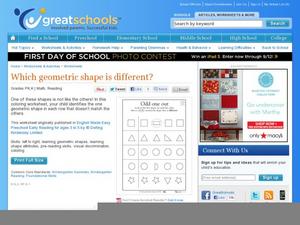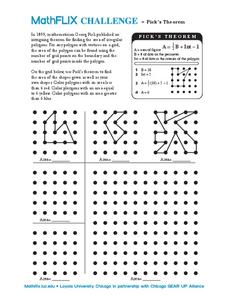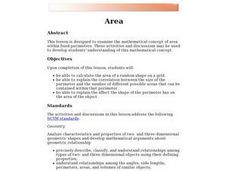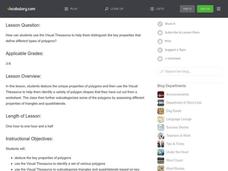Curated OER
Investigation - Adrienne's Pattern Block Angles
Fifth graders investigate possible solutions to a word problem. They explore properties of polygons and right angles. Students demonstrate proper angle measurement. Students discover patterns.
Curated OER
Which Geometric Shape is Different?
What is the difference between a star and a triangle? Its attributes of course. Discuss the basic shapes with your class, then have them practice identifying shapes by circling the one in each row that is different.
Curated OER
Net "Working"
Upper elementary and middle schoolers explore the properties of various polygons. They use video, resource links, and engage in hands-on activities in order to construct geometric nets. This fine plan should lead to increased...
Curated OER
Some Shapes
Introduce the names and properties of basic 2-D shapes. Images and defining features of the circle, rectangle, triangle, and square are shown. Each image is colorful and includes a happy, smiling face, perfect for younger learners.
Curated OER
Polynominoes
In this polynominoes worksheet, students solve 9 different types of polynominoes problems. First, they identify that a polynominoe is a polygon made from squares of the same size and connected to each square. Then, students determine how...
Curated OER
Interactivate - Lines, Rays, Line Segments, and Planes
Students explore lines, rays, line segments, and planes. In this math lesson, students discuss the math concepts and direct their instructor in graphing functions. Students collaborate in graphing additional functions.
Curated OER
Interactivate - Geometry in Tessellations
Students use an on-line worksheet to experiment with patterns of tessellations in regular polygons. As students observe different shapes in the "Tessellate" Activity they complete a data table and practice making predictions for...
Curated OER
Learning About Triangles
Upper graders label four triangles and fill in the labels correctly. They draw three original triangles and answer the questions about them.
Curated OER
2-D Shapes: properties Review
Play to review the various properties that help us identify 2-D shapes. Five different shapes are presented first by their properties only, these clues are then used to identify each shape. This is a great warm up activity, especially...
Curated OER
Ruler and Compass Constructions
Fourth and fifth graders examine how to construct perpendicular lines and to bisect angles using rulers and compasses in this unit of lessons. They design a number of polygons using these methods.
Curated OER
Area of Regular Quadrilaterals
Can your class calculate the area of a regular quadrilateral? They can now, with this handy presentation which provides an explanation, the formula, and examples of finding the area of a regular 2-D shape.
Curated OER
Quadrilaterals: 2 dimensional shapes with 4 straight sides
Which shapes are considered quadrilaterals? View and learn that two dimensional shapes with four straight sides are considered quadrilateral. The rhombus, parallelogram, rectangle, and trapezium are only few of the fabulous shapes...
Curated OER
2-D Shapes Show
As the green squares are removed, a little piece of the puzzle is revealed. What is it? A square, a triangle, a cow? Have your class guess their way to identifying five different plane shapes.
Curated OER
2-D Shape Recognition
How many of 2-D or plane shapes can your class identify? Can they get them all? Little learners view and review the names of nine different shapes, such as rectangle, square, triangle, and circle, to name a few.
Curated OER
2-D polygons
A hands-on activity uses the Zome modeling system, and helps young geometers either learn or review their knowledge of polygons. Pupils build as many different 2-dimensional polygons as possible: triangle, square, rectangle, pentagon,...
Curated OER
Finding Areas of Polygons and Circles
In this math worksheet, students find the areas for the shapes. They apply the appropriate formula for each shape that is drawn and in the word problems.
Curated OER
Area and Perimeter Quiz
For this mathematics worksheet, students give the area and perimeter of each polygon illustrated on the sheet. There are six different polygons to measure on the sheet.
Curated OER
Pick's Theorem
In this Pick's Theorem activity, students solve and graph 6 different problems that include using Pick's Theorem to solve. First, they use Pick's Theorem to determine the area of the shapes given as well as their own shapes drawn. Then,...
Alabama Learning Exchange
Polygon Perimeters
What are polygons? Learners find the perimeter of various geometric figures that the teacher has drawn in chalk on the sidewalk. A worksheet to record their measurements is provided. Get your third graders outside and exploring the world...
Curated OER
Area Applet
Elementary math classes calculate the area of a shape and explain the correlation between the size of the perimeter and the areas that can be contained within that perimeter. They also explain the effect the shape of the perimeter has on...
Curated OER
Transportation from Around the World
Take a look at how people around the world get from here to there. Each slide provides an image and description of various types of transportation found around the globe. In Venice they use a boat, in San Francisco they use a Trolley...
Curated OER
Symmetry and Geometric Shapes on Campus
Build on your learners' previous knowledge of geometric shapes and symmetrical figures. Then set them out to take photos of geometric shapes on campus. They assess whether the photos contain symmetry or not.
Curated OER
Independent Practice 2: Recognizing Similar and Congruent
Learners examine given figures and determine if they are similar and congruent or similar and not congruent. Afterward, they match congruent figures drawn in a table. This one-page worksheet contains 12 problems.
Curated OER
Know Your Polygons!
Young scholars identify and categorize different polygons. In this polygons lesson plan, students research and identify properties of polygons, identify different polygon shapes, and categorize different triangles and quadrilaterals.

























